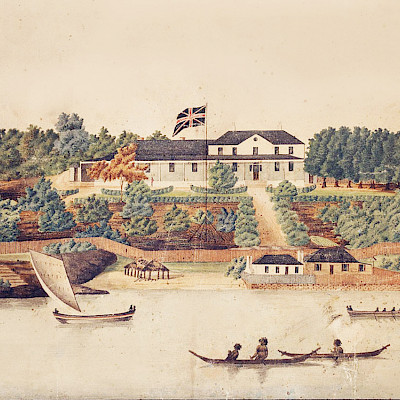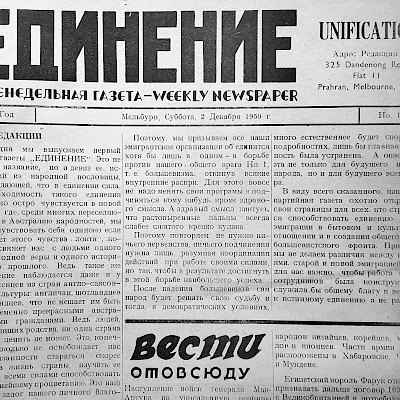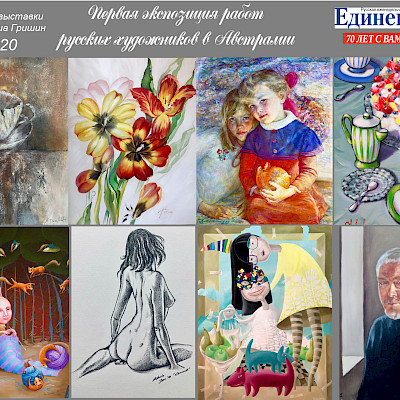People who ended up in prisoner-of-war camps during World War II often kept diaries in which they described everyday life behind the barbed wire. Many such memoirs have been published since the end of the war. Arseny Josephovich painted many portraits of comrades in misfortune, creating a quite unique gallery; a one of its kind.
For those who have not heard of this artist, it is worth briefly talking about his background. The youngest son of Colonel Joseph Martynovich Savitsky and his wife Olga Vitalievna (nee Verigo), he was born in 1903 in the ancient city of Yegoryevsk (before the revolution – the Ryazan province, and now the Moscow region). At the age of ten, the young boy was sent to the Khabarovsk Cadet Corps, in Far East Russia where his older brother, George, was already studying. There were also two daughters in the Savitsky family - Tatiana and Margarita.
Arseny could have become a good army officer, but in 1917 the revolution broke out, quickly followed by the Civil War, and five years later the last hotbed of resistance to the Reds – Primorye, was brutally suppressed. Together with his brother and uncle, Major General Leonid Verigo, as part of the Siberian Squadron of Rear Admiral G. K. Stark, Savitsky left Russia forever and was demobilised in Shanghai amongst cadets and civilians before the flotilla left for the Philippines.
After a while he managed to get a job at an advertising company, where he began his career in illustration. In Shanghai, the artist met his future wife, Elena Starchenko. Their first son, Cyril, was born in 1929, and then Nikita in 1933. The Savitsky family then decided to settle in Hong Kong, where the head of the family found a job in one of the local advertising agencies.
In addition, Arseny's relatives on his mother's side also lived there – the Verigo family. Perhaps on the advice of his cousin, Vitaly, he joined the local police force as a reservist in 1936. Despite the fact that the Russian community in Hong Kong was not very large, the immigrants managed to organize an Orthodox parish named after the Holy Apostles Peter and Paul, where the Savitskys became tireless helpers.
With the outbreak of World War II and the entry of Japan into the hostilities, the situation in Southeast Asia became very tense, and the colony began to prepare for its own defense. In the summer of 1940, the evacuation of British subjects began with mainly women and children. One of the first such transports to leave Hong Kong for Australia arrived in Brisbane on 8th of August and on 25th of November Elena Savitsky and her two children disembarked the Nellore steamer at the same local port.
On 8th of December 1941 the Japanese offensive on Hong Kong began and on Christmas Day they completed the captured of the island. Almost the entire 15,000-strong, battle-weary garrison of the Commonwealth armed forces was captured, and about 3,000 residents were forced into civilian internment in Stanley Camp. Amongst others were members of the colonial administration, local businessmen, policemen and firefighters.
The conditions of detention in the camp were described in the diary of John Coleman Charter (1912-1989), a British civilian who was originally born in Ceylon, worked in Hong Kong as an architect in the City Council and who was interned in the camp with his wife. A very detailed memoir of the family was published several years ago in the form of a book, "The First must be the Last: John's War Diary and the Memoirs of Yvonne Charter. Hong Kong 1940-1945 and Stanley Camp", which was published by his son, Anthony.
Within the book it says that one day an art exhibition was held in the camp. Among all the works John noted a series of portraits of internees and "some of them are excellent", adding that they were painted by a "British Russian man named Savitsky", about whom they say "is talented and self-taught." It is not known how many drawings and paintings Arseny created in Stanley Camp, but relatives believe that there were more than 200 of them.
I will not try to analyze his brush strokes or dissect his technique, as that is the job of art critics. I am much more interested in the people that the artist painted, and their stories and ultimate destinies. After all, the uniqueness of these drawings is not just that he captured his comrades in misfortune, but also that some of them are the only surviving images of prisoners of the camp, since not everyone had the luxury of taking lifestyle photos during internment.
Among the prisoners of Stanley Camp was Roland Henry John Brooks, Deputy Chief of the Hong Kong Fire Department. His family came from London in 1922 when Ron was just 12 years old. In the colony, his father, Henry, worked as the Head of the fire department and his son was also to follow in his footsteps - after graduating from a school for junior command personnel (which, by the way, Brooks Sr. was instrumental in helping to establish), he served in the fire brigade.
In November 1939 Roland got married, but soon after the newlyweds would have to part ways – Helen was evacuated to Australia and a year later, Ron, along with his mother and sister, ended up in the camp. After the war, the firefighter returned to service and after retiring for health reasons in 1955 (he was injured in service), he and his family moved to New Zealand. Brooks died in 1970 of a heart attack at the age of 60.
There is also a very interesting gallery of images of Richard Walter Mills - a bank employee from the London borough of Newham, who obviously came to the colony shortly before the war began and was also interned in Stanley Camp. The prisoners managed to obtain the right to conduct leisure activities and an amateur troupe was created in the camp which rehearsed in the hall of St. Stephen's College, located next door. His performances were very popular with the audience.
Richard turned out to be a diverse actor. He managed both comedic (Johnny Jelliwell in "Spring Time for Harry", Inspector Stack in "Laburnum Grove", Eliot Chase in "Private Lives") and dramatic roles (Captain Hardy in "The Night before Trafalgar", Joseph in the Christmas play, Pontius Pilate in "Good Friday"). He even managed to play the evil sister in "Cinderella". John Charter, also a member of the troupe, spoke well of him in his diary. After the war, Mills returned to England and he died in Swindon, Wiltshire, in 1974 at the age of 64.
The life of Edmund Colin Luscombe turned out to be more tragic. He joined the Hong Kong Police in 1937 as a trainee, and two years later became an assistant superintendent. After the fall of the island, together with his colleagues, he ended up in Stanley, where Arseny painted his portrait in a winter uniform on 30th of March, 1942. After his release, Edmund continued his work with the police and rose to Assistant Commissioner and honorary adjutant to the Governor of Hong Kong.
On September 1, 1950, while commanding a group of officers during the detention of a dangerous criminal who had barricaded himself in a house in the village of Ha Kwai Chung, the bandit opened fire and two policemen were killed - Edmund was wounded in the heart and died on the spot. The officer was only 33 years old and left a wife and two children. Many years later, the family donated a copy of the portrait and several photographs of Edmund to the Hong Kong Police Museum. Apparently, those photographs are not digitized yet, so this is the only image of Luscombe available on the internet.
Savitsky also painted three portraits of John P. Pennefather-Evans, who in 1914, as an intern, joined the police of the Federated States of Malaya (now Malaysia). In the spring or summer of 1941, shortly before the Japanese invasion, he was appointed commissioner of the Hong Kong police and soon he shared the fate of his colleagues, ending up in Stanley Camp. The name of this policeman is repeatedly mentioned in Charter's diary and several memoirs of other prisoners who were in the camp.
After the war in 1951, Pennefather-Evans was appointed Commissioner of Police in Singapore where he served for about a year and from there, most likely, he moved to England. Two drawings of the camp times were included in "Pennefather-Evan’s Scrapbook", which was still carefully kept by the family in London. Its head lived a long life – he died in 1977 at the age of 83.
And the third portrait is among the cartoon style sketches of the prisoners of block No. 10 on the so-called "Mess No. 25" (top right) – this drawing was also included in the "Scrapbook". Opposite John is Archibald Henry Elston who was born in London in 1897, and during the First World War served as a corporal in the 7th London Infantry Regiment. In 1916 on the front line of the Battle of the Somme, he was seriously wounded and most likely discharged, but despite this, he joined the police.
In 1919 he moved to Hong Kong, married five years later and had two sons – Jeremy and Michael. During World War II, his wife and children were evacuated to Sydney Australia, where Marjorie worked as a government censor. Most likely, after Archibald retired in 1949, the Elstons moved to New Zealand. He died in 1973 and was buried at Waihiki Cemetery in Auckland. Other images of this policeman have not been found yet.
Below on the left is Arthur William Smith born circa 1895 – another native of London, who served in the Hong Kong police from 1919 and ended up in Stanley with his colleagues. He retired almost immediately after the war, but soon returned to work and served for another five years, finally resigning in 1950. Thanks to Arseny, we know that Arthur loved to smoke a pipe and this is also his only known portrait to date.
In the blue uniform and a cap opposite is William Richard Chester-Woods. He was born in 1896 in Hounslow, a western suburb of London. He joined the Hong Kong Police in 1919, rose to the rank of Chief inspector and Director of the police school. In early December 1941 he was transferred to the Food Control Office. After his release from Stanley he retired. William was one of the founders of the Old Comrades Association. He died in 1946 and was buried in the Colonial Cemetery.
There is very little information about Bernard P. Thorpe (left) and Stanley George Smith pictured in the bottom row of "Mess No. 25". Bernard was born in 1897, served in the police from 1921 and was attached to the Immigration Service before the occupation of Hong Kong. The second one, Stanley, was five years younger than him, joined the police in 1922 and rose to the rank of junior inspector.
Sometimes Arseny did not specify the names of the people who posed for him and only inscribed the date and his signature. By using the Hong Kong Police badge numbers (the Russian unit had the letter "E") it is possible to identify who is depicted in the lower left corner of photo no. 10 - this is Vitaly Veriga, he was designated with badge number E22. Badge number E25 (top right) is Fedor Zadorin and so far, this is also the only image of him. Unfortunately, I could not find any information about police officer No. E27 or the person on the top left who was drawn without any identification marks.
The pastel sketch shows Nora Mary Potter, a native of West Ham, Essex, together with a boy in a sling (a traditional device for carrying children in Southeast Asia). Her husband, John, was an architect. In September 1941 the couple had a son - Christopher John. On Christmas Day, when Hong Kong fell to the Japanese, Nora’s husband died. We can only guess how this young woman felt having just lost her husband and finding herself interned in the camp with a three-month-old baby in her arms...
Immediately after her release Nora returned to England and in 1948 moved to New Zealand. In 1957 she married Allan Ruffalo and worked as a typist. The former Stanley prisoner died in 1996 at the age of 85 and was buried in the Napier Cemetery. Her son, Chris, wrote a book about his childhood memories in the camp - "My Beautiful Island: from England to New Zealand through Hong Kong and the war", which was recently published.
The Offenberg family were interned in full force behind the barbed wire: Adrianus Cornelis, the chief manager of the large Dutch shipping company Royal Interocean Lines South East Asia, who engaged in cargo and passenger transportation and who’s office was located in Hong Kong; his wife, Johanna Maria Gerard and children: sisters Anneke (born in 1929) and Tanneke (born in 1933) and the youngest son, Arnold Cornelis, born in July 1940.
The artist painted their portraits in sepia in 1944. It is known that Anneke moved to Australia and lived in Manly, the northern coastal area of Sydney. After her marriage she changed her surname to Kekwick. In March 2015, Arnold, the youngest of the Offenbergs, passed away and Anneke died nine months later. Mrs. Tanneke Robertson survived her brother and sister for 5 more years.
Even in the harsh conditions of the camp Arseny managed to maintain a sense of humor. In a sort of a playful wall newspaper, which reflects some moments of the "working day at Stanley", he produced a happy birthday sketch, placing his self-portrait in the center. But who was the birthday boy? His cousin Vitaly Veriga (known as Vic in the camp) who was born on March 4, and the artist's birthday was October 25...
After release Arseny left for Brisbane where his family was waiting for him. He still worked in advertising, painted paintings and also icons. The Savitskys changed their surname to Martin - in honor of the grandfather of the head of the family, were active members of the Russian community and worked for the church community. For our fourth church, the Holly Annunciation Church on Park Road in Woolloongabba, the master created many images for the iconostasis. The artist died three years after his wife's death in 1987 and was buried at Mount Gravatt Cemetery next to her.
Victoria Smolin (Russia) and Keith Clark (UK)
PS:
We sincerely thank the relatives of the characters of this article for the information, photos and carefully preserved art heritage of A. J. Savitsky. The illustrations are taken from open sources on the Internet and photo №14 by V. Smolin. Special thanks to the B&CF page (Facebook) and the “Old Hong Kong” website, their owners and volunteers for their tireless work and touching memories of past days.
Photo captions:
01 - Arseny Savitsky in a group of reservist policemen
02 - John C. Charter kept a diary, which later became a book
03 - Exhausted and suffering from beriberi - Stanley prisoners
04 - Firefighter Roland H. J. Brooks saved people before retiring
05 - Bank employee Richard W. Mills played in the camp theater
06 - "Morning Bulletin" (2nd September 1950) article about the death of a policeman
07 - Savitsky painted three portraits of John P. Pennefather-Evans
08 - "Mess No. 25" - Prisoners of Block No. 10
09 - Graves of William R. Chester-Woods and Archibald H. Elston
10 - The names of some people could not be established (No. E27 and top left)
11 - The story of Nora Porter is described in the memoirs of her son Christopher
12 - The whole Offenberg family was behind the barbed wire
13 - An ordinary day at Stanley in the camp wall newspaper
14 - Grave of Elena and Arseny Savitsky (Martin) in Mount Gravatt































